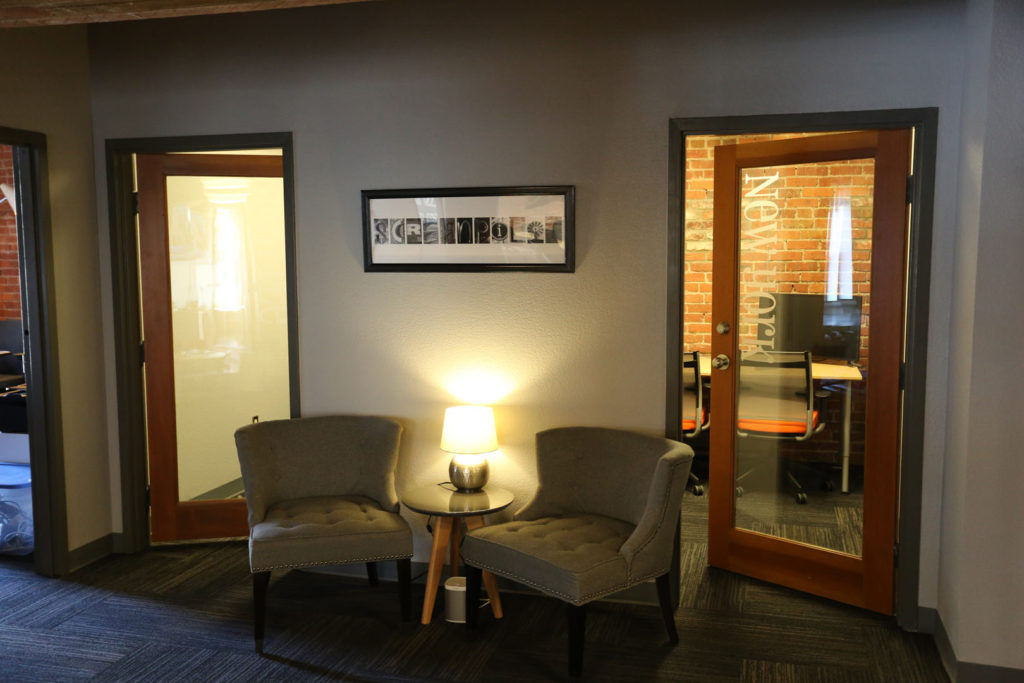How to Crush Your Next Tenant Improvement or Interior Construction Project
How to Crush Your Next Tenant Improvement or Interior Construction Project
Tips from Business Owners on the Commercial Renovation Process
May 31, 2017

photo by Becky Dibble, Screen Pilot
A collaboration effort with Screen Pilot (Owners Tom & Becky Dibble)
written by: Audrey Wilson
We’ve been building tenant improvements for a while now. And while we feel pretty strong we know the order of things, the real story is the experience from the client’s perspective. After all, a tenant improvement indicates some type of shift for their business, generally a move toward growth or new experiences–these are moments of celebration!
As a general contractor, our hope is to make the transition seamless, so tenants can focus on their own priorities. However, how do we really know if we are on the right track? What is it like from the client’s perspective? How else can we be preparing and supporting our clients? For fresh perspective, we decided to unveil the other side of the story.
Clients Tom and Becky Dibble of Screen Pilot, graciously agreed to talk with us about their tenant improvement experience. Their hospitality-focused marketing agency recently expanded into an entire floor of a historic building in Downtown Denver and hired us for general contracting.
THE INTERVIEW:
Snyder Building Construction (SBC): Before we dive into your direct experience with the expansion construction, thank you! We had a great time building your new space. We’d love to know more about what takes place inside these walls. Tell us more about Screen Pilot.
Screen Pilot – Becky: We started as a small consulting firm, operating out of a home office, to now, a 20-person, thriving agency who continue to grow their client base. We built Screen Pilot on the desire to create a digital marketing agency that could deliver engaging and enviable client experience with pride and commitment.
SBC: You picked Denver over London, your hometown—I love it.
Becky: Yes, our roots are firmly in the Mile High City, although we’d like to think an office in London is a possibility, in our future!
SBC: Clearly, the expansion means you’re growing and needed more space. Why expand in a historic building rather than go somewhere new?
Screen Pilot – Tom: Expanding as the only tenant on this floor meant more privacy and a sense of growth that we are experiencing not only in head count but as a business overall. Downtown Denver is burgeoning with new builds left, right and center, and it’s an amazing location on LoDo, we wanted to stay in the thick of it all.
SBC: And you really are so close to everything. 16th street mall, Union Station, some of the most amazing Denver restaurants—having met your team this choice absolutely fits the vibe at Screen Pilot. On the inside, how did you prioritize team needs and decide the floor plan layout?
Tom: We wanted to create a much more open plan space and sectioned off private meeting rooms for client meetings and internal meetings. That way we could accomplish both sense of privacy and collaboration.
SBC: It seems like the finished outcome definitely accomplishes what you were hoping for. On a random note, we were curious, did you have any previous experience with the commercial tenant improvement process?
Tom: When taking the lease in the first place, our initial experience with commercial construction was limited to what the landlord was managing. So very little. On a commercial basis, we had no experience working with a general contractor.
SBC: No way—y’all asked all the right questions! I would have never known. When you started the process, what kind of relationship did you hope to have with your GC? And what were your priorities during the construction process?
Tom: Trust was paramount. If you can’t trust your GC, you may as well do it yourself! We also wanted to mitigate noise for both the commercial and residential tenants in our mixed-use building, but also get the job done to plan, on-time and on budget.
SBC: We couldn’t have said it any better. Trust allows the project to move together smoothly and allows for more conscious decision making when discrepancies arise. This kind of relationship ultimately leads to on-time, on-budget projects.
The construction experience from the perspective of other people and businesses is obviously crucial in a historic, mixed-use building like yours. Commercial tenants are working during the day and families are at home early in the morning and in the evenings.
SBC: Were there any surprises during the process?
Tom: Not really surprises as such, but that’s not a bad thing!
Becky: During the demo phase, pipes and strange electrical wirings were exposed, not a huge surprise due to renovating a building of its age. Thankfully, a quick call from our GC meant an effective and satisfactory outcome so the project was not delayed.
In the end, we had to know how we did overall—the good, the bad, and the ugly.
Tom (in his kind, British accent) simply said, “You guys crushed it. Apart from the standard sticker shock of the cost of commercial construction, which is universal I feel, having you guys running the project has been one of the better referrals that I’ve had for a service provider in a long time. The attention to detail and acute attentiveness to our needs but also running the tradespeople on the job from what we saw was fantastic.”
“At the start of our construction project, the whole team helped pack up our existing office and we all headed home to work. Our company thrives on teamwork and collaboration, so getting back together within the same space as soon as possible was paramount. SBC ensured this happened as efficiently as the project allowed,” said Becky.

photo by Becky Dibble, Screen Pilot
Ultimately, their trust in us made for a great relationship and project experience. We had no idea Becky and Tom were unexperienced in commercial construction. They were always so confident and asking great questions.
Tips from Tom & Becky:
- “Select your GC carefully and make sure you have your architects start talking to your GC earlier than you think you need to.” – Tom Dibble, Screen Pilot
- Your general contractor’s attention to detail, communication, and level of organization will either help put you at ease or add stress to the transition.
- Plan your space to include multiple work environments for varied tasks. Think about open space, private conference or work rooms, and relaxing/collaboration areas.
Thank you to Tom and Becky for trusting us to build your downtown space and for your continued partnership. We look forward to continue watching Screen Pilot grow!

photo by Becky Dibble, Screen Pilot
About Screen Pilot:
Screen Pilot is a Denver-based, digital marketing agency that specializes in telling the stories of hotels, resorts and hospitality brands through inspired communication. Learn more at www.screenpilot.com.




Recent Comments